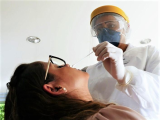A study published yesterday in the Journal of Infection has found that staff working at more than one London nursing home during the peak of the UK COVID-19 outbreak had a quadruple risk of infection.
Also, JAMA Network Open today published a research letter showing that US nursing homes that reported COVID-19 cases also had high numbers of deficiencies and substantiated complaints citing failures to comply with federal infection-control requirements.
Working at more than one site
The first study involved testing 250 staff members at six nursing homes with outbreaks for infection with SARS-CoV-2, the virus that causes COVID-19, in April and asking about any symptoms, contact with residents, and whether they worked in more than one home.
The researchers found that 14 of 27 (52%) of staff working at different facilities were infected, versus only 37 of 223 (17%) working in a single home, a 4.2-fold difference (95% confidence interval, 2.1 to 8.4; P < 0.001).
Seven of 15 workers (47%) who reported regular contact with residents and sometimes worked at different care homes tested positive for COVID-19, versus 7 of 12 (58%) of staff with regular resident contact who often worked at different sites.
Of staff working at a single facility, 2 of 13 (15%) reported no contact with residents, while 7 of 45 (16%) said they had occasional resident contact, and 28 of 165 (17%) reported regular interactions with residents. Similarly, testing of serum samples of London community-dwelling residents showed a 17.5% prevalence of antibodies against COVID-19, indicating current or previous coronavirus infection.
In total, 51 of 250 staff members (20%) tested positive for COVID-19, but only 11 (22%) reported symptoms.
Staff-resident, staff-only clusters
Whole-genome sequencing (WGS) identified coronavirus clusters involving staff members only, including some involving staff—some with minimal resident contact—working at more than one facility.
WGS also identified multiple introductions of the virus into nursing homes with large outbreaks, as well as evidence of staff-resident clusters.
"Given that stringent infection control practices, including closure to visitors, were reported to be in place by the time of testing, staff working across care homes (most of whom asymptomatic at the time of testing) were, therefore, a significant potential source and reservoir of SARS-CoV-2," the authors wrote.
The researchers recommended incentives for staff to work in a single care home, full training of temporary staff members in infection-control measures, and regular staff coronavirus testing. "Infection control should be extended for all contact, including those between staff, whilst on care home premises," they said.
By May 1, 22,000 excess deaths in England and Wales had occurred among nursing home residents, making up 54% of all excess deaths in those countries.
Outbreaks in a third of facilities
In the second study, researchers in Philadelphia analyzed data from 8,943 nursing homes in 23 states and Washington, DC, from Apr 22 to 29. The data became available after the Centers for Medicare & Medicaid Services began requiring long-term care facilities to report COVID-19 cases.
They parsed data from nursing homes that did and didn't report COVID-19 cases for 5-star quality ratings (overall and staffing and deficiency ratings), deficiencies (total health deficiency score, reported deficits due to emergency preparedness, incidents, and substantiated complaints), staffing (for direct-care staff, registered and licensed practical nurses, and nurse aides), facility characteristics (for-profit ownership, beds, and Medicaid-insured residents), and county-wide coronavirus infection rates.
Of 8,943 long-term care facilities, 3,021 (33.8%) had reported coronavirus outbreaks by Apr 29. Nursing homes that reported and didn't report infections had similar mean 5-star ratings (3.2 for both) and similar star ratings on deficiencies (2.7 vs 2.8) and staffing levels (2.9 vs 3.0).
County-wide, facility cases
Compared with facilities that reported no coronavirus infections, those that reported COVID-19 cases had more reported health deficiencies (56.2 vs 67.0 in nursing homes with outbreaks), emergency preparedness deficits (3.2 vs 3.9), reported incidents (1.1 vs 2.4), and substantiated complaints (4.0 vs 5.7).
For-profit nursing homes reported more coronavirus cases than their not-for-profit counterparts (2,383 [78.9%] vs 4,090 [69.1%]), and facilities that reported cases had a higher mean percentage of residents insured by Medicaid than those that did not (59.3% vs 56.7%).
Mean community COVID-19 case numbers were nearly double in counties in which facilities reported infections (428.2 per 100,000 residents vs 231.3 in counties in which nursing homes didn't report cases).
"The largest difference between nursing homes with and without COVID-19 cases was observed in county-level rates of COVID-19, suggesting that when the surrounding population case rate is high, area nursing homes are at a high risk of infections," the authors wrote.
They added that nursing homes have experienced years of declining revenues and financial problems.
"These factors have made many facilities ill prepared for a pandemic, and stemming the spread of COVID-19 in nursing homes will not be easy," they wrote.


















